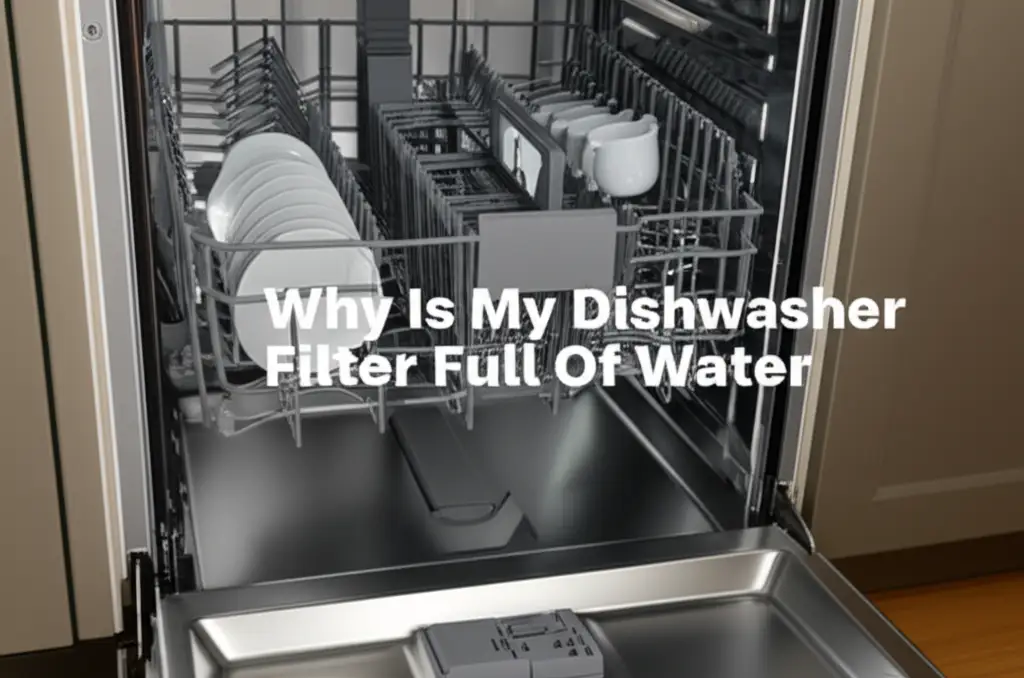· Davia Murnell · Appliance Maintenance · 21 min read
Why Is The Inside Of My Dishwasher Turning Brown

Why Is The Inside Of My Dishwasher Turning Brown?
You open your dishwasher, expecting sparkling clean dishes. Instead, you see unsightly brown stains covering the interior walls or racks. This can be quite alarming. Many homeowners face this issue, wondering what causes it and how to fix it. A brown dishwasher interior suggests a problem with your water, cleaning habits, or the appliance itself.
This article explores the common reasons your dishwasher is turning brown. We will discuss issues like hard water, food residue, and detergent use. I will also provide clear solutions to remove these stains. You will learn practical tips for prevention. By the end, you will understand how to keep your dishwasher looking new. Let’s make your dishwasher clean again.
Takeaway:
- Hard water, especially with iron or manganese, is the most common cause of brown stains.
- Regular cleaning of the dishwasher filter and interior is crucial for preventing buildup.
- Using the correct amount and type of detergent, along with rinse aid, helps prevent residue.
- Addressing rust on racks or internal components can stop further discoloration.
- Checking your dishwasher’s drainage system prevents dirty water from settling.
The inside of your dishwasher turns brown primarily due to mineral deposits from hard water, particularly iron and manganese. Other causes include excessive food soil, improper detergent use, or rust from internal components. Identifying the specific cause helps you choose the right cleaning method and prevent future discoloration.
Understanding the Brown Stain Mystery: Why Your Dishwasher Changes Color
Seeing your dishwasher interior turn brown can be confusing. This discoloration is not just dirt. It often points to specific issues within your home’s water system or your appliance’s usage. Brown stains appear gradually over time. They are often a sign of mineral accumulation or other types of residue. Understanding these reasons helps you address the problem effectively.
Many people think a brown dishwasher means the appliance is old or broken. This is often not the case. The brown color usually comes from external factors. It could be something in your water. It might also be related to how you load dishes or use detergent. Identifying the source is the first step toward a cleaner dishwasher. We will explore the common reasons behind this discoloration. This knowledge helps you tackle the problem directly.
The brown stains can range from light yellowish-brown to a deep reddish-brown. The exact shade often gives clues about the cause. For example, reddish-brown often indicates iron. A darker, almost blackish-brown might suggest manganese or heavy grease buildup. I find it helpful to observe the color closely. This small detail can guide your troubleshooting process. You can then select the most effective cleaning strategy.
Ignoring these stains can lead to problems. They can reduce your dishwasher’s cleaning efficiency. They might also harbor unpleasant odors. A dirty dishwasher cannot properly clean your dishes. It is important to address the brown stains quickly. This keeps your appliance running well. It also ensures your dishes get truly clean.
The Primary Culprit: Hard Water and Mineral Deposits
Hard water is the most common reason for a brown dishwasher interior. Hard water contains high levels of dissolved minerals. These minerals include calcium, magnesium, iron, and manganese. When this water heats up and then dries, these minerals leave deposits behind. This buildup sticks to the dishwasher’s walls, racks, and heating element. Over time, these clear deposits can react with cleaning agents or food particles, leading to a visible brown or reddish-brown stain.
I have personally seen many homes with hard water issues. It is a widespread problem. These mineral deposits are difficult to remove with regular washing. They require specific cleaning agents or methods. The brown color comes from different minerals. Iron creates a reddish-brown stain. Manganese creates a darker, sometimes purplish-brown stain. Knowing your water quality can help you understand the stains.
Iron and Manganese in Water
Iron and manganese are common culprits for brown staining. These metals naturally occur in groundwater. They can enter your home’s water supply. When water with high iron content runs through your dishwasher, the iron oxidizes. This creates rust-like particles. These particles settle on the interior surfaces. They bond with the plastic or stainless steel. This results in a reddish-brown or rusty appearance.
Manganese also causes similar stains. Manganese leaves behind a darker, almost blackish-brown film. Both minerals are more noticeable when present in high concentrations. You might notice similar stains in your toilets or sinks if you have these minerals. These stains are stubborn. Regular dishwashing detergent does not remove them. They need specialized cleaners that target mineral buildup.
Detecting Hard Water
You can easily detect hard water in your home. Look for white, chalky residue on faucets and showerheads. This is limescale, a sign of calcium and magnesium deposits. You might also notice your soap does not lather well. Your clothes might feel stiff after washing. For a more precise check, you can buy a home water testing kit. These kits are affordable and provide quick results.
Knowing your water hardness level helps you decide on solutions. If you have very hard water, a water softener might be a long-term solution for your whole house. If the problem is only in the dishwasher, specific cleaning products can help. You can also adjust your detergent usage. I always recommend testing your water if you suspect hard water. This gives you clear information to act on.
Food Particles and Grease Buildup: A Sticky Situation
Even though a dishwasher cleans, it can also get dirty from food. Over time, tiny food particles and grease can accumulate inside. These are not always washed away completely. They can stick to the sprayer arms, the filter, and the internal walls. When these particles dry and combine with minerals, they can create a sticky, brown film. This film is a common cause of discoloration.
I know some people think pre-rinsing dishes is unnecessary. However, leaving large food scraps on dishes contributes to this buildup. The dishwasher’s filter is designed to catch these. But if it gets overwhelmed or not cleaned regularly, food can redeposit. This re-deposited food, especially greasy residues from sauces or oils, can cook onto the interior surfaces during cycles. This results in a persistent brown stain.
The Role of Pre-Rinsing
Many modern dishwashers claim you do not need to pre-rinse. This is true for many normal food soils. However, heavy grease, sticky sauces, or large food bits should be scraped off. Pre-rinsing ensures these larger particles do not clog your dishwasher. It reduces the burden on your dishwasher’s filter. This simple step helps prevent food from becoming a source of brown stains.
I always scrape excess food into the trash before loading dishes. This small effort makes a big difference. It helps the dishwasher work more efficiently. It also keeps the interior much cleaner. You don’t need to get the dishes sparkling clean before loading. Just remove the big pieces. This prevents a lot of internal residue.
Filters and Sprayer Arms
Your dishwasher has a filter system. This system catches food debris during the wash cycle. If this filter becomes clogged, it cannot effectively trap particles. Dirty water then circulates throughout the dishwasher. This redeposits the food particles onto supposedly clean dishes and the dishwasher walls. The filter needs regular cleaning. I recommend checking it weekly.
The sprayer arms also need attention. Small holes on these arms spray water onto your dishes. If these holes get clogged with food particles or mineral deposits, water spray becomes weak. This reduces cleaning effectiveness. It leaves more food residue inside the machine. Clean the filter and sprayer arms regularly. You can often twist or unscrew the filter for easy removal. Then rinse it under running water to clear away debris. This simple cleaning prevents many brown stain issues. You can learn more about how to clean your dishwasher filter here.
Detergent Residue and Dishwasher Performance
Sometimes, the problem is not about what’s in your water or on your dishes. It can be about your detergent. Using too much detergent, or the wrong type, can leave residue. This residue combines with food particles and minerals. It then creates a film inside your dishwasher. This film can appear brown over time. It can also make your dishes cloudy.
Detergents are designed to break down grease and food. However, they need to be rinsed away completely. If the dishwasher does not rinse properly, or if there is too much foam, residue remains. This residue becomes a sticky trap for other contaminants. It then dries and hardens into unsightly brown stains. It is a common cause people often overlook.
Using Too Much or Wrong Detergent
More detergent does not always mean cleaner dishes. In fact, too much detergent creates excessive suds. These suds can prevent water from properly reaching all surfaces. They also make rinsing more difficult. The detergent residue can then build up. This residue turns brown as it collects dirt and minerals. You should always follow the detergent manufacturer’s recommendations. For soft water, you often need less detergent.
Using the wrong type of detergent also causes issues. Only use detergent specifically made for automatic dishwashers. Hand dish soap will create too much foam and can damage your machine. Powder, gel, or pod detergents all have different properties. Experiment to find what works best with your water type and dishwasher. I personally find pods convenient and effective for consistent dosing.
Dishwasher Rinse Aid’s Function
Rinse aid is a very important part of dishwasher cleaning. It helps water sheet off dishes and the interior surfaces. This prevents water spots and promotes faster drying. More importantly, rinse aid helps prevent mineral and detergent residue from sticking. It breaks the surface tension of water. This allows for better drainage. Without rinse aid, water droplets dry on surfaces, leaving behind all their dissolved minerals.
This means a lack of rinse aid can worsen brown stains. The water and detergent residue simply sits on the surfaces. It then dries and becomes brown. Always keep your rinse aid dispenser filled. Most dishwashers have an indicator light for this. Using rinse aid helps keep the interior sparkling. It also improves your dish cleaning results. It is a small step with a big impact.
Rust and Corrosion: Metal Components Breaking Down
Another reason for brown stains inside your dishwasher is rust. Rust forms when metal parts inside your dishwasher corrode. This often happens on the racks. The plastic or nylon coating on the racks can chip or wear away. This exposes the metal beneath. Once exposed to water and detergent, the metal begins to rust. These rust particles then flake off. They attach to the dishwasher walls and your dishes.
Rust stains are typically reddish-brown. They are very distinctive. You might notice small rust spots on your dishes or silverware. This is a clear sign that rust is forming somewhere inside the machine. Over time, these small spots merge into larger brown patches. Checking your racks regularly for chips is a good idea. Catching them early can prevent larger problems.
Rusting Dishwasher Racks
Dishwasher racks are frequently exposed to water and chemicals. Their protective coating is crucial. If this coating cracks or peels, the steel wire underneath rusts. This rust then washes off during cycles. It spreads throughout the dishwasher. It sticks to the plastic interior, creating stubborn brown stains. Repairing or replacing rusted racks is important. You can buy touch-up paint specifically for dishwasher racks. This paint is designed to seal minor chips.
If the racks are heavily rusted, replacement is the best option. Continuing to use rusty racks will only make the brown stains worse. It also poses a risk to your dishes. Rust particles can transfer to your food. I once had a dishwasher with heavily rusted racks. The brown stains were impossible to remove until I replaced the racks. It made a huge difference.
Internal Metal Parts
Besides racks, other internal metal parts can also rust. The heating element, screws, or even the spray arm assembly might contain metal components. If these parts are not stainless steel or have a damaged coating, they can corrode. The rust from these parts will also spread. It will create brown discoloration inside your machine. This is less common but still possible.
Checking these parts might require some disassembly. If you suspect an internal component is rusting, consult your dishwasher’s manual. Or consider calling a professional. Fixing these issues early prevents widespread staining. It also prolongs the life of your appliance. A quick inspection for rust now can save you headaches later.
Poor Drainage and Standing Water Issues
A dishwasher needs to drain all water completely after a cycle. If water remains inside, it can cause problems. This standing water often contains dissolved food particles, minerals, and detergent residue. As the water sits and evaporates, it leaves behind a concentrated brown film. This film can be very stubborn to remove. Poor drainage is a common issue leading to unsightly stains and odors.
Many factors can lead to poor drainage. A clogged filter is a primary culprit. The drain hose can also become kinked or obstructed. Sometimes, the drain pump itself has an issue. Any of these problems prevent dirty water from exiting the machine. This allows the brown-causing elements to settle and accumulate. I always check for standing water after a cycle. It is a clear warning sign.
Clogged Filters and Drains
Your dishwasher’s filter traps food debris. If you do not clean it regularly, it gets clogged. A clogged filter prevents water from draining properly. It also allows dirty water to recirculate. This leads to food particles redepositing inside the machine. These particles combine with minerals and detergent to create brown sludge. Cleaning your dishwasher filter regularly is very important.
The drain hose also needs to be clear. Food debris, grease, and even small objects can get trapped in the drain. This restricts water flow. You can usually access the drain area by removing the lower spray arm and filter. Clear any visible blockages. If the drain hose is the issue, it might need to be disconnected and flushed. This often requires professional help. You can find more tips on how to clean a dishwasher drain here.
Drain Hose Problems
The dishwasher drain hose connects to your home’s plumbing. It typically goes to the garbage disposal or a dedicated drain line. If this hose is kinked, twisted, or installed incorrectly, it can impede drainage. A common issue is a low-hanging drain hose. It should have a high loop to prevent backflow. Without this loop, dirty water from the sink can flow back into the dishwasher.
Check the drain hose for any obvious kinks or blockages. Ensure it is properly installed. If you have a garbage disposal, make sure its knockout plug was removed during dishwasher installation. This plug is for dishwashers and must be taken out for proper drainage. Sometimes, the problem is not inside the dishwasher but in the plumbing connection. Solving these drainage issues helps keep your dishwasher clean and free of brown stains.
The Role of Water Temperature and Cycle Settings
The temperature of the water used in your dishwasher cycle plays a crucial role in cleaning effectiveness. If the water is not hot enough, detergents cannot fully dissolve or activate. This means they cannot properly break down food soils and grease. Cold water also allows minerals to settle more easily. This can contribute significantly to brown staining inside the machine.
Modern dishwashers often have internal heating elements. These ensure water reaches the correct temperature. However, external factors can impact this. Your home’s water heater setting might be too low. Or, if the dishwasher is too far from the water heater, water might cool before reaching the appliance. Choosing the right cycle setting also matters. A heavy-duty cycle uses hotter water and longer wash times. This helps with tough stains and prevents buildup.
Insufficient Hot Water
For optimal cleaning, dishwashers need water at least 120°F (49°C). If your hot water supply is below this temperature, your detergent might not work efficiently. Food and grease will not dissolve properly. Minerals will also be more prone to depositing. This creates a prime environment for brown stains. You can check your water heater’s temperature setting. Adjust it if needed.
Running your hot water tap in the kitchen for a minute before starting the dishwasher also helps. This ensures hot water is already in the pipes. It avoids the dishwasher filling with cold water at the start of the cycle. This simple step can significantly improve cleaning performance. It helps prevent those stubborn brown stains from forming.
Choosing the Right Cycle
Dishwashers offer various cycle settings. These include light, normal, heavy, and express washes. Each cycle uses different water temperatures, wash times, and spray intensities. Using a light cycle for heavily soiled dishes will not provide adequate cleaning. It will leave behind food residue and contribute to staining. Always match the cycle to the soil level of your dishes.
For dishes with dried-on food or a greasy film, use a heavy-duty or sanitize cycle. These cycles use hotter water and longer wash times. This helps dissolve tough stains and minerals. Regularly running a hot cycle, even with an empty load and a cleaning agent, can prevent brown buildup. This is part of maintaining a clean dishwasher. I always use a heavier cycle for pots and pans. This prevents accumulation of grease.
Comprehensive Cleaning Strategies for Brown Stains
Once brown stains appear, you need to clean them. Regular dishwashing detergent will not be enough. You need specific cleaning strategies. These strategies target the mineral deposits, rust, or grease causing the brown color. There are several effective methods. These include natural solutions and commercial cleaners. The best approach depends on the severity and type of stain.
Always start with a simple, thorough cleaning. Remove the racks and clean the filter. Then, inspect the spray arms for clogs. After this basic maintenance, proceed with a deeper cleaning method. Regular deep cleaning prevents the stains from returning. It also keeps your dishwasher running efficiently. A clean dishwasher cleans dishes better.
Deep Cleaning with Vinegar
White vinegar is an excellent natural cleaner for dishwashers. It is acidic. This acidity helps dissolve mineral deposits, like limescale and rust. Vinegar also deodorizes and helps with grease. To clean with vinegar, first remove all dishes and silverware. Place a cup of white vinegar in a dishwasher-safe bowl on the top rack. Run an empty hot water cycle.
The hot water and vinegar will work together. The vinegar will break down the mineral buildup. You can also spray vinegar directly onto stubborn stains inside the dishwasher. Let it sit for a while before running a cycle. Repeat this process monthly for maintenance. I find this method very effective and natural. For detailed instructions, see how to clean a dishwasher with vinegar.
Baking Soda Power
Baking soda is another natural cleaning agent. It is mildly abrasive and helps scrub away stains. It also absorbs odors. After the vinegar cycle, or on a separate day, sprinkle a cup of baking soda on the bottom of your empty dishwasher. Run a short, hot cycle. The baking soda will help remove any remaining residue. It will also brighten the interior.
You can also make a paste with baking soda and water. Apply this paste to stubborn brown spots. Let it sit for 15-20 minutes. Then, scrub gently with a non-abrasive brush or sponge. This helps lift embedded stains. Combining baking soda with vinegar can create a powerful cleaning reaction. Learn more about cleaning your dishwasher with baking soda here.
Commercial Dishwasher Cleaners
Many commercial dishwasher cleaners are available. These products are formulated to tackle specific issues. Some target hard water stains. Others focus on grease and food buildup. They often contain strong acids or enzymes. Follow the product instructions carefully. These cleaners are usually used in an empty dishwasher cycle.
Some popular brands offer effective solutions. These cleaners can be a good option for severe or persistent brown stains. They are designed for deep cleaning and maintenance. Use them as directed, typically once a month or every few months. I use commercial cleaners for a really deep clean a few times a year. This keeps things fresh.
Targeting Specific Stains: Rust, Grease, and Scale
Different types of brown stains require specific treatments. Knowing the exact cause of your brown dishwasher helps you choose the most effective cleaner. For instance, a cleaner excellent at removing hard water scale might not be as effective against rust. Similarly, a rust remover will not fully tackle heavy grease deposits.
It is important to identify the main type of stain. Is it reddish-brown (likely iron rust)? Is it dark and greasy (food buildup)? Or is it light brown and chalky (mineral scale)? Once you know, you can pick the right product or method. This makes cleaning much more efficient. I always try to diagnose the stain first.
Removing Iron Stains
Iron stains appear reddish-brown or orange. They are common in homes with well water or older pipes. These stains are best treated with cleaners that contain oxalic acid or citric acid. White vinegar is a good natural option due to its acetic acid content. For tough iron stains, commercial rust removers designed for appliances can be very effective.
Make sure the product is safe for your dishwasher’s interior material. Stainless steel and plastic react differently. Apply the cleaner directly to the stain. Let it sit for the recommended time. Then, scrub with a non-abrasive brush. Run an empty cycle afterwards to rinse thoroughly. Repeated treatments might be necessary for very old stains.
Tackling Grease Deposits
Grease stains often appear dark brown and feel sticky or slimy. They accumulate from fatty foods. These stains are best removed with strong degreasers. Dishwashing detergent itself is a degreaser. However, for built-up grease, you need a more concentrated approach. Hot water is also key to breaking down grease.
You can use a strong dish soap solution mixed with very hot water. Scrub the greasy areas with a sponge or cloth. For a deep clean, baking soda is effective. Its mild abrasive quality helps cut through grease. Running a hot water cycle with a dishwasher cleaner specifically designed to cut grease can also help. Ensure the water temperature is high enough to melt the grease away during the cycle.
Eliminating Limescale
Limescale is a white, chalky deposit. It turns brown when it traps other impurities or reacts with iron. Limescale comes from calcium and magnesium in hard water. Acids are the best way to remove limescale. White vinegar is highly effective. Lemon juice is another natural acidic option. Commercial descalers specifically target limescale buildup.
To remove limescale, run an empty cycle with a cup or two of white vinegar. For stubborn areas, apply vinegar directly and let it soak. Scrub with a non-abrasive pad. Rinse aid also helps prevent limescale buildup over time. It makes water sheet off surfaces more effectively, carrying minerals away. Regular use of rinse aid is a good preventive measure.
Preventive Measures to Keep Your Dishwasher Spotless
Prevention is always better than cure. Keeping your dishwasher from turning brown involves a few simple habits and regular maintenance. These steps will save you time and effort in the long run. They also ensure your dishwasher performs at its best. A well-maintained dishwasher lasts longer and cleans dishes more effectively.
I have found that a consistent routine makes all the difference. You do not need to do everything every day. A weekly check-up and a monthly deep clean usually suffice. These small efforts prevent major buildup. They also make your cleaning efforts much easier when you do them. Let’s look at the key preventive steps.
Regular Maintenance Schedule
Establish a regular cleaning schedule for your dishwasher. This includes daily, weekly, and monthly tasks.
- Daily: Scrape large food particles off dishes before loading. This prevents clogs and buildup.
- Weekly: Check and clean the dishwasher filter. This is one of the most important steps. A clean filter ensures proper drainage and prevents redeposition of food debris. Also, quickly wipe down the door gasket and edges.
- Monthly: Run an empty hot water cycle with a dishwasher cleaner. You can use vinegar, baking soda, or a commercial cleaner. This helps remove mineral buildup and grease. For a comprehensive guide on keeping your dishwasher clean, you can check out how to clean the inside of a dishwasher.
This routine helps you stay ahead of stains. It stops them before they become a problem. I always mark my calendar for monthly cleaning. This ensures I never forget.
Water Softener Solutions
If hard water is the main cause of your brown stains, a water softener might be the ultimate solution. A whole-house water softener removes minerals like calcium, magnesium, iron, and manganese from your entire water supply. This protects all your appliances and plumbing. It also improves soap lathering and reduces skin dryness.
Installing a water softener is an investment. However, it can significantly reduce hard water problems in the long term. It prevents not just dishwasher stains but also buildup in washing machines, water heaters, and pipes. If a whole-house system is not feasible, consider a dishwasher-specific water treatment product. Some detergents also contain water-softening agents.
Proper Detergent Use
Using the correct





